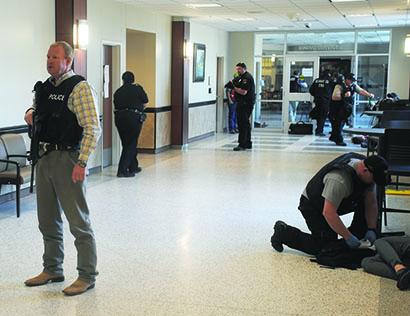tives from local enforcement practiced how they would handle an active shooter situation Wednesday.
The active shooter drill was held at Cogdell Memorial Hospital, in the business offices and cafeteria. The scenario involved two people portraying shooters and Snyder High School theater students posing as victims.
The drill covered a variety of scenarios and elements related to a shooting situation, including hostages and bomb threats. While police officers and sheriff’s deputies dealt with the shooter and attempted to eliminate the threat, paramedics assisted victims and transported them to the emergency room.
The drill lasted about an hour. Later in the day, drill participants, along with hospital staff members, met to review what went well and what needed to be improved. Snyder Police Chief Terry Luecke said he believed the drill was, on the whole, a success.
“Overall, I think it was a good response,” Luecke said. “I thought the response time was good. It was a good learning experience.”
Some of the issues Luecke and other emergency response leaders discussed afterward related to communication and how quickly response teams moved to the scene.
Luecke said “teams got bottle-necked” and left spaces open and unsecured when they should have had at least one or two officers in position.
Communication problems included some responders not being able to hear when Code Silver (code for an active shooter) or Code Yellow (mass casualty situation) were called.
Another communication issue was that the handheld communication devices that the hospital uses did not work properly.
Also, the emergency room, like many rooms in the hospital, requires a hospital employee’s badge to be scanned in order to gain access to and from the room. Because some of the medics did not have badges, they were locked inside the emergency room as they attempted to assist more victims.
Scurry County EMS Shift Supervisor Jimmy Futrelle said all paramedics were issued badges and should have had them. He also said the triage process needs to improve.
“That’s one of the things we’re going to have to work on,” Futrelle said. “It needs to be a little more efficient.”
Luecke said he felt that despite the mistakes, it was a good experience and he hopes all involved can learn from it.
“This is why we have these drills,” Luecke said. “It’s better to make mistakes now than in a real scenario.”
Image
Body


